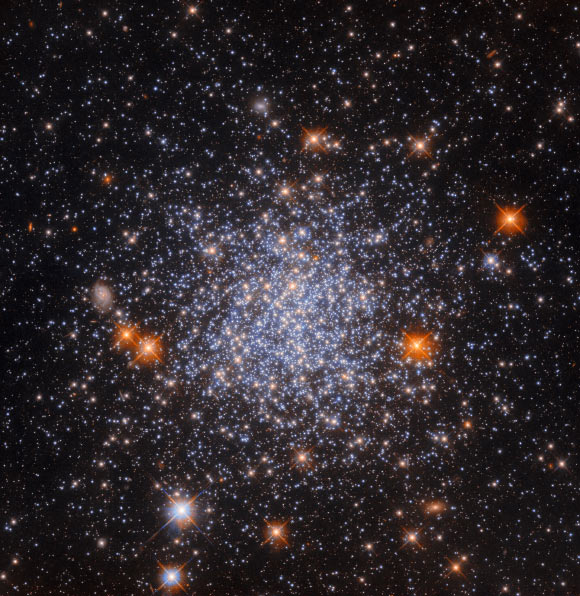Astronomers using the NASA/ESA Hubble Space Telescope have captured a detailed image of NGC 1651, a globular cluster located in the constellation of Mensa.
This Hubble image shows NGC 1651, a globular cluster some 162,000 light-years away in the constellation of Mensa. Image credit: NASA / ESA / Hubble / L. Girardi / F. Niederhofer.
Globular clusters are densely packed, spherical collections of hundreds of thousands or even millions of stars.
They are among the oldest known objects in the Universe and are preferentially associated with the oldest components of galaxies.
Our Milky Way Galaxy hosts at least 150 such objects and a few more are likely to exist hidden behind the Galaxy’s thick disk.
NGC 1651 is part of the Large Magellanic Cloud, the largest and brightest of the Milky Way’s satellite galaxies.
First discovered by the English astronomer John Herschel on November 3, 1834, this globular cluster lies approximately 162,000 light-years away in the constellation of Mensa.
Otherwise known as ESO 55-30 or LW 12, NGC 1651 has a diameter of 120 light-years.
“A notable feature of this image is that NGC 1651 almost fills the entire image, even though globular clusters are only about 10 to 300 light-years in diameter,” Hubble astronomers said.
“In contrast, there are numerous Hubble images that feature entire galaxies — which can be tens or hundreds of millions of light-years in diameter — that also more or less fill the whole image.”
The color image of NGC 1651 is made up of observations from Hubble’s Wide Field Camera 3 (WFC3) in the near-infrared and optical parts of the spectrum.
“A common misconception is that Hubble and other large telescopes manage to observe wildly differently sized celestial objects by zooming in on them, as one would with a specialized camera here on Earth,” the astronomers said.
“However, whilst small telescopes might have the option to zoom in and out to a certain extent, large telescopes do not.”
“Each telescope’s instrument has a fixed ‘field of view’ (the size of the region of sky that it can observe in a single observation).”
“For example, the ultraviolet/visible light channel of WFC3, the channel and instrument that were used to collect the data used in this image, has a field of view roughly one twelfth the diameter of the Moon as seen from Earth.”
“Whenever WFC3 makes an observation, that is the size of the region of sky that it can observe.”
“The reason that Hubble can observe objects of such wildly different sizes is two-fold,” they said.
“Firstly, the distance to an object will determine how big it appears to be from Earth, so entire galaxies that are relatively far away might take up the same amount of space in the sky as a globular cluster like NGC 1651 that is relatively close by.”
“In fact, there’s a distant spiral galaxy lurking in this image, directly left of the cluster — though undoubtedly much larger than this star cluster, it appears small enough here to blend in with foreground stars!”
“Secondly, multiple images spanning different parts of the sky can be mosaiced together to create single images of objects that are too big for Hubble’s field of view.”


